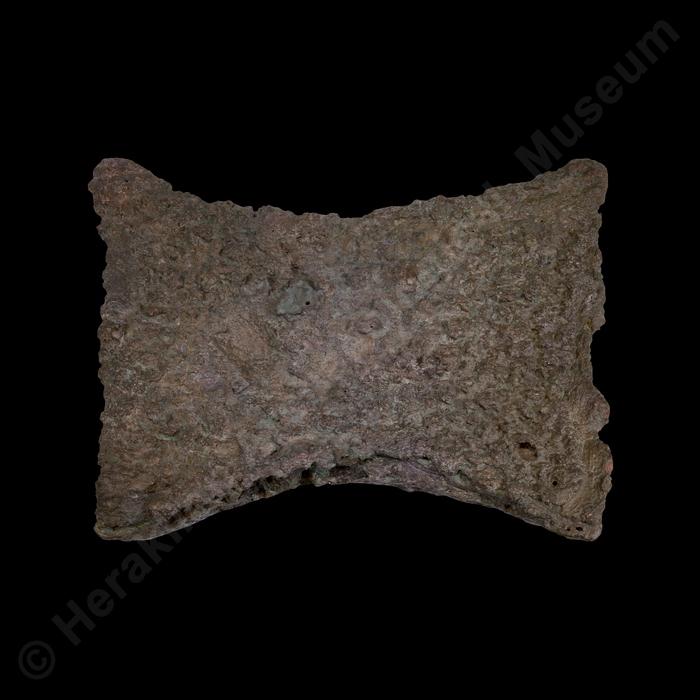Copper ingot
Χ726
Metal (Bronze)
All surfaces corroded and porous
Length: 37 cm. Width: 35 cm. Weight approx. 30 kg
Hagia Triada
Royal Villa
Neopalatial period:
1450 BC:
Gallery:
XXICase:
207Exhibition thematic unit:
Cretan CoinagePre-numismatic transactions and coinage in Crete (2nd millennium BC - 2nd c. AD)
Description
Oxhide copper ingot (also known as a talent), one of a hoard of 19 similar ingots, the largest known hoard in Minoan Crete. This is one of the early standardised ingot shapes, resembling a stretched oxhide without the head, and weighs very close to the average weight of 29 kilos. Its shape, its ease of use, transportation and hoarding, and the survival of the term “talent” as an accounting currency in the barter economy of the Greek cities in the Historical period, have all led to the recognition of the ingot as an early means of engaging in large-scale transactions, a proto-coin, besides the fact that it was undoubtedly valuable imported raw material for making artefacts. Analyses have shown that most of the ingots from Agia Triada probably come from Asia Minor, while the copper of the majority of similar ingots from other Late Minoan settlement contexts of Crete comes from the largest mining centre of the Mediterranean, Cyprus.Bibliography:
Α. Lioliou, Προκερματικές μονάδες στην Πρώιμη Εποχή του Σιδήρου (11ος–6ος αι. π.Χ): η περίπτωση της Κρήτης, Ρέθυμνο 2014, unpublished MA diss., pp. 26-31 and passim. F. E. Lo Schiavo et alii, “An Oxhide Ingot Fragment from ‘Piazzale dei Sacelli’, Ayia Triada (Crete) to the National Archaeological Museum, Florence” in Graziadio et alii (eds), Φιλική Συναυλία.Studies in Mediterranean Archaeology for Mario Benzi, Oxford 2013, 49–60. R. Seaford, Money and the Early Greek Mind: Homer, Philosophy, Tradegy, Cambridge 2004, p. 34, ch. 2. D. M. Schaps, The Invention of the Coinage and the Monetization of Ancient Greece, The University of Michigan 2004, 69ff. N. H. Gale - Z. A. Stos-Gale, "Oxhide Copper Ingots in Crete and Cyprus and the Bronze Age Metals Trade", BSA 81(1986), pp. 81-100. A. L. Macrakis,“Comparative Economic Values in the Iliad: The Οxen–worth” in A. L. Boegehold et alii (eds), Studies Presented to Sterling Dow on his Eightieth Birthday, Durham 1984, 211–216.Author:
K. S.Photographs' metadata
